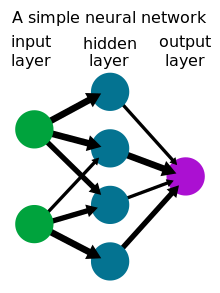A neural network can refer to either a neural circuit of biological neurons (sometimes also called a biological neural network), or a network of artificial neurons or nodes in the case of an artificial neural network. Artificial neural networks are used for solving artificial intelligence (AI) problems; they model connections of biological neurons as weights between nodes. A positive weight reflects an excitatory connection, while negative values mean inhibitory connections. All inputs are modified by a weight and summed. This activity is referred to as a linear combination. Finally, an activation function controls the amplitude of the output. For example, an acceptable range of output is usually between 0 and 1, or it could be −1 and 1.

These artificial networks may be used for predictive modeling, adaptive control and applications where they can be trained via a dataset. Self-learning resulting from experience can occur within networks, which can derive conclusions from a complex and seemingly unrelated set of information.

